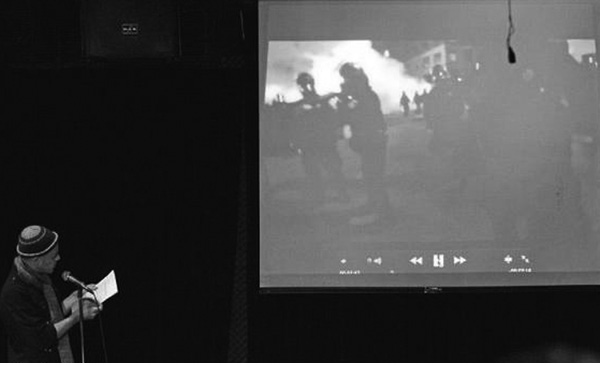
WE ARE ALL SOUND
first performed on February 18, 2012
Bowery Poetry Club, New York, NY
performed twice in 2012
DAVID BUUCK
Abby Crain, Erika Staiti
Oakland, CA
davidbuuck.com
WE ARE ALL SOUND
DAVID BUUCK
This performance explored how to aesthetically represent police brutality against Occupy activists in Oakland without resorting to tropes such as sensationalism, romanticized heroism, voyeurism and the like.
I stood center stage and announced that we would hear instructions for a dance I would refuse to perform. My collaborator, Abby Crain, then read aloud a series of instructions for movement, which had been transcribed from livestream videos of police brutality at Occupy Oakland actions. Without revealing the source material, however, the audience merely watched me standing still, listening to a set of abstract and flat instructions (such as, “lift your left arm 90 degrees, twisting at your torso to the right”). After this reading and (non-)performance, I then screened a video containing the scenes from which the movements had been isolated and transcribed. Over the video, I repeated the instructions, this time changing the pronouns and verb tenses (e.g., “we watched you lift your arm 90 degrees, twisting your torso to the right”). At times the video clips were slowed down or repeated, in order to focus on the body being beaten while also abstracting the visual representation, with its low-rez pixilation and the often blurry, handheld, nighttime constraints. At the end of the video, there is a brief clip that moves between an older black man pounding his fist while speaking at an Occupy rally and a younger white man performing ASL translation. Over these images I sang an improvised blues plaint, feigning lyrics by moving between moans and words.
By juxtaposing vivid images of protestors being beaten with the comparatively flat descriptions of their bodies’ movements, I wanted to question modes of aesthetic representation of bodies in pain. By placing my body center stage, yet refusing to follow the instructions (i.e., re-enact the beatings), I attempted to question the ethics of artists “speaking for” or “on behalf of” others, even though as an active participant in Occupy Oakland I wanted to also show solidarity: to both show the brutality and show the refusal to uncritically turn it into a fixed artwork. Singing over the final image was intended to bring in additional modes of representation and translation, using the voice to mediate the visuals of others bodies performing public political speech, in vocal and embodied response to violent political repression.
Also performed for Small Press Traffic at Artists Television Access in San Francisco.